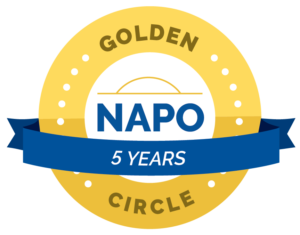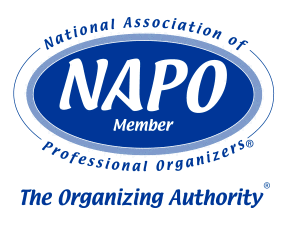 Historically, “get organized” is in the top ten New Year’s Resolutions. I’m not a big believer in resolutions, but I’m a big believer in goals. And I think getting organized is a fantastic goal.
Historically, “get organized” is in the top ten New Year’s Resolutions. I’m not a big believer in resolutions, but I’m a big believer in goals. And I think getting organized is a fantastic goal.
As you might imagine, I get a lot of calls this time of year. People are energized behind their goal (see, I’m eliminating “resolution” already) to “get organized” in the new year and are looking for support. Some people know what they need to do to accomplish their organizing goal, others need some assistance.
If you are feeling a little stuck, try some of these tips:
- Check your motivation: What was your motivation around the get organized goal? Ask yourself “why did I set this goal?” Possible answers could be: save time, save money, reduce stress, get out of the house on time, reduce clutter, etc. The answer to that question will help motivate you toward action.
- Confused on where to start?: Start with your biggest pain point. Is your kitchen so disorganized making coffee is a hassle? Are you spending so much money on things you already own that your finances are getting stretched? Are you stressed about not getting to work on time because you can’t find your keys? Success in your biggest pain point area will motivate you to move on to the next. If you can’t decide where your largest pain point is, close your eyes and point toward an area. Progress anywhere may lead to success everywhere.
- Set aside time to organize: I’ve found a lot of people are very aspirational when it comes to planning projects (and organizing is a project). They say “I’ll get to that next week.” Well, next week comes and goes. I suggest people mark organizing time on their calendar. When your calendar says “organize the pantry on Saturday between 2:00 – 4:00,” chances are the organizing date will be kept.
- Sort items into three large categories: Most items can be categorized into three major groups: Keep, Give, Toss.
- If you use it and love it, keep it and give it a place of honor and respect.
- If it’s functional but you no longer use it or love it, give it away. Determine the best place for the giveaway item. The best place could be a relative, friend or charity. Whatever you decide, set a deadline to get it out of your space and into theirs.
- If it’s no longer functional, toss it. Some of my clients find this to be a difficult part of the process because they are concerned about contributing to our landfill problems and I appreciate that mindset. I encourage my clients to check with their local municipality regarding recycling and check out alternatives to just throwing something away. For example, my recycle station accepts household metal like toasters and Goodwill will accept clothing that’s no longer wearable (just mark the donation as “textile recycle”). Research and creativity can keep a lot of things out of landfills.
- Track your progress: Take a “before” picture of the space you are working on and continue to take pictures throughout the organizing process. Even if you haven’t completed the process, seeing change is motivating. Be sure to take a photo after you’ve completed the project not only as a reminder of how far you’ve come, but to give yourself a clear picture of what you’d like the space to look like on an ongoing basis.
I encourage my clients to remember a couple things:
- Organizing is not only a project, but a way of life. Once you are organized enough for your lifestyle, a few minutes a day will help maintain your newly-organized spaces.
- Largely attributed to Sheryl Sandberg “Done is better than perfect.” The thought that something needs to be perfect will stop us in our tracks.
Whatever you do, don’t give up on your new year’s goals like the Allstate “Mayhem” character has!
Cindy Jobs, COC, ACC
Looking for more information?
Click here for 15-minute organizing tips.
National Association of Productivity & Organizing Professionals, Seattle Chapter
National Association of Professional Organizers, Seattle Chapter Vice President
Institute for Challenging Disorganization
Level I Certificates earned in Chronic Disorganization; ADD; Client Administration; Time Management; Mental Health; and Hoarding.
Level II Specialist Certificates earned in Chronic Disorganization and ADHD.













